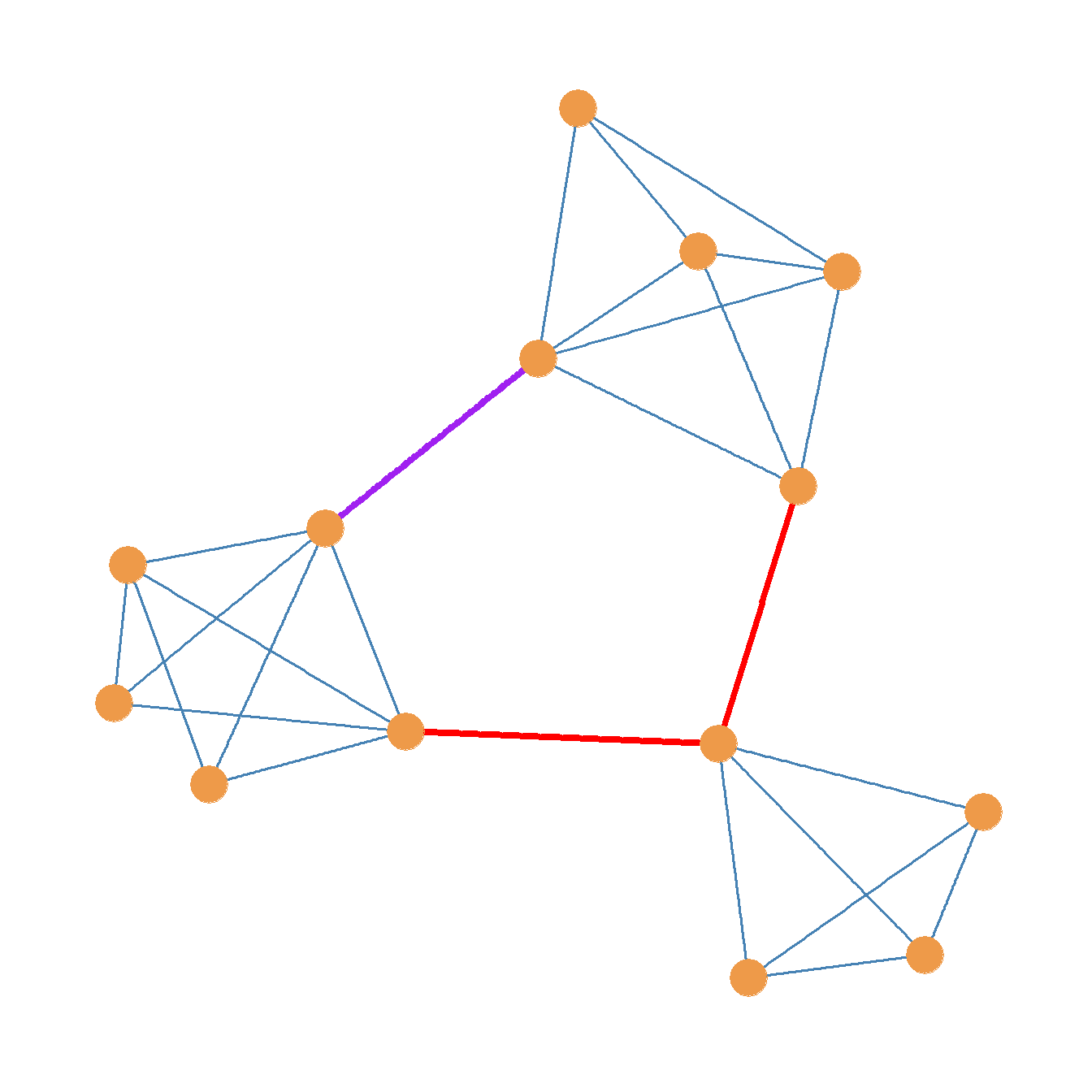
13 Graph Connectivity
13.1 Connected and Disconnected Graphs
Look at Figure 11.1 again. Are there any disconnected pairs of nodes in the graph? The answer is no. If you pick any pair of nodes, they are either directly connected, or indirectly connected to one another via a path of some length. So how can we get two nodes to be disconnected in a simple undirected graph? The answer is that there has to be some kind of “gap” splitting the graph into two or more pieces, so that some set of nodes can no longer reach some of the other ones.
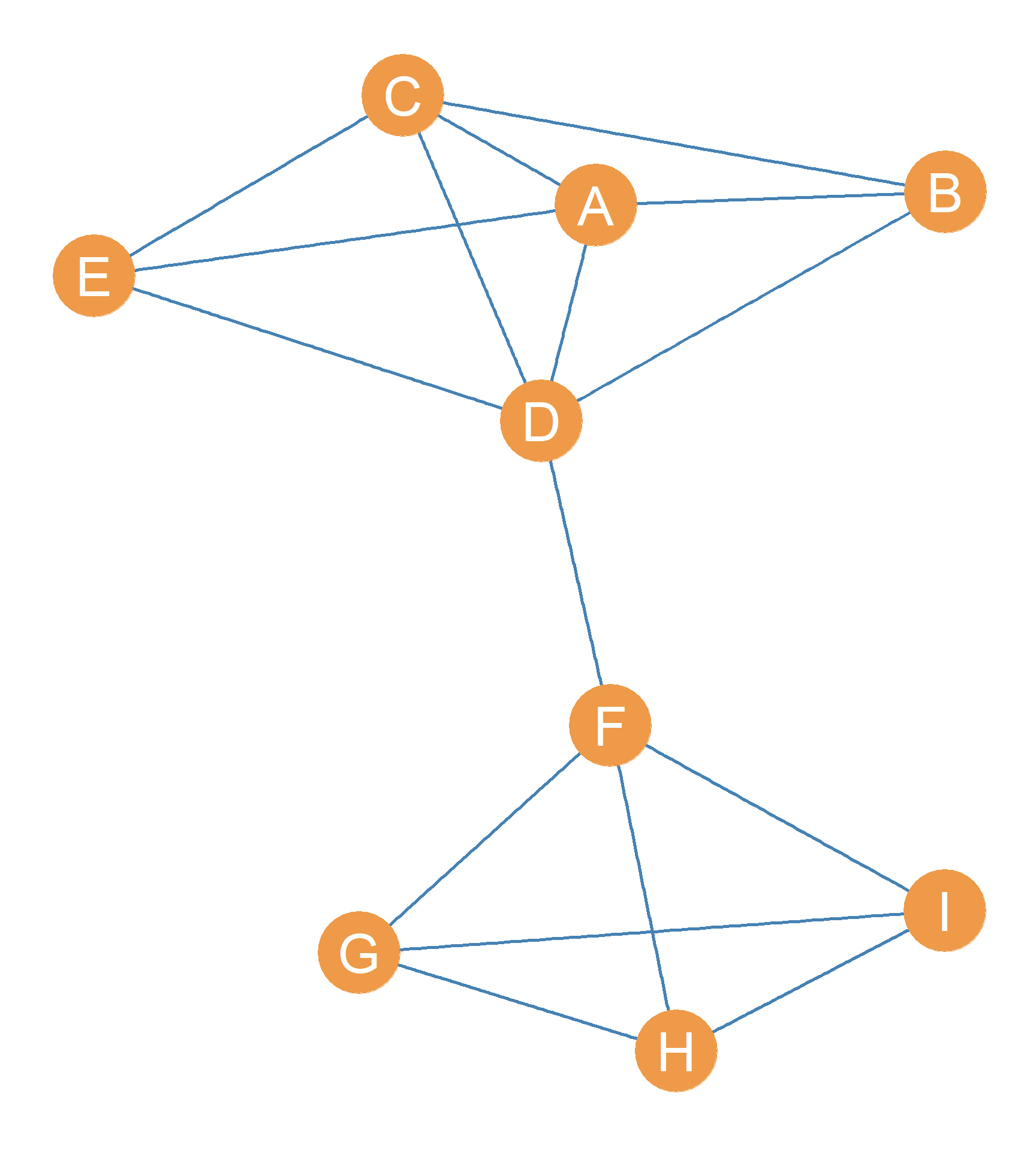
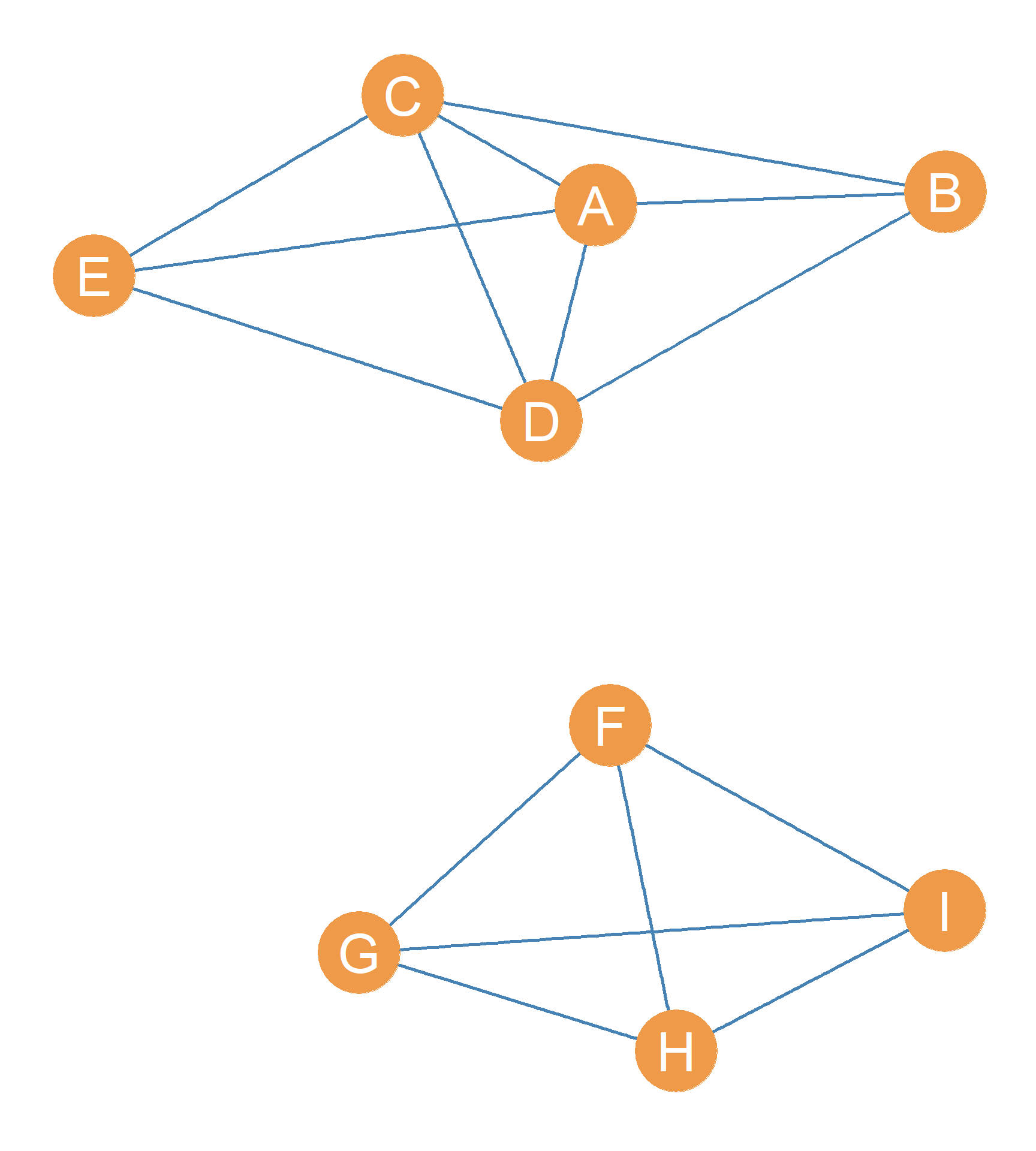
For instance, if you compare the undirected graphs Figure 13.1 (a) and Figure 13.1 (b) you can appreciate the difference between a connected graph and a disconnected graph. The difference between Figure 13.1 (a) and Figure 13.1 (b) is that the Figure 13.1 (b) graph is a subgraph of the Figure 13.1 (a) graph, in which the \(DF\) edge has been removed (an edge-deleted subgraph according to what we discussed in Chapter 4): \(G(b) = G(a) - DF\).
Removing the \(DF\) edge has resulted in \(G(b)\) being disconnected. There is no way we can trace a path connecting any of the vertices in the \(\{F, G, H, I\}\) subset with any of the vertices in the \(\{A, B, C, D, E\}\) subset. This is different from Figure 13.1 (a) where we can trace a finite path between any two vertices, even if it is very long. Thus, we can come up with a formal definition of graph connectivity:
A graph is connected if there exists a (finite) path between each pair of nodes.
A graph is disconnected if there does not exist a path connecting every pair of nodes
13.2 Components and the Giant Component
When a graph goes from connected (like Figure 13.1 (a)) to disconnected (like Figure 13.1 (b)) it is split into a number of subgraphs that are themselves connected.
For instance, in Figure 13.1 (b) the set nodes \(\{A, B, C, D, E\}\) form a connected subgraph of the larger disconnected graph. A connected subgraph that is part of a larger disconnected graph is called a component.
In Figure 13.1 (b) there are two components, one formed by the connected subgraph with node set \(\{A, B, C, D, E\}\), and the other formed by the connected subgraph with node set \(\{F, G, H, I\}\).
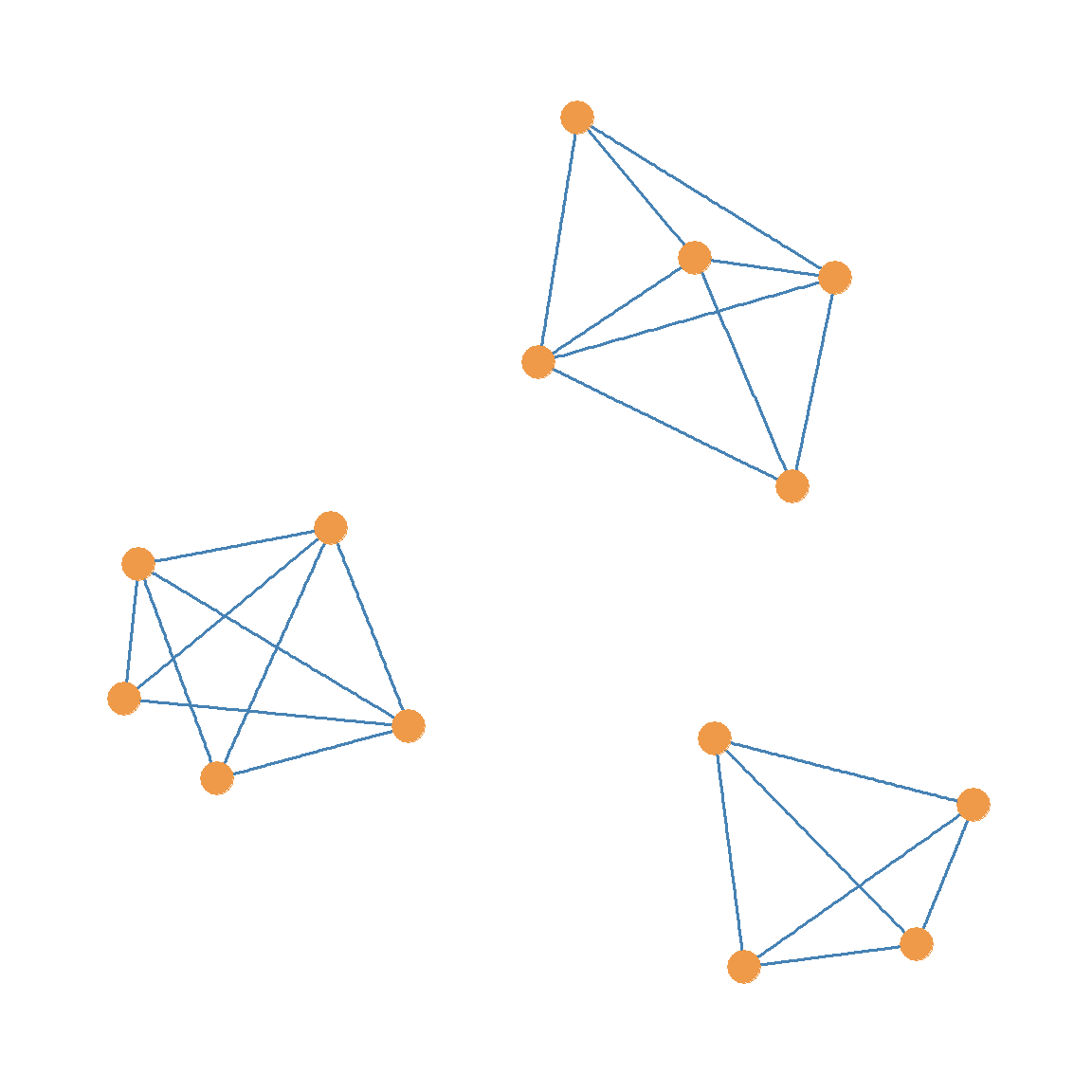
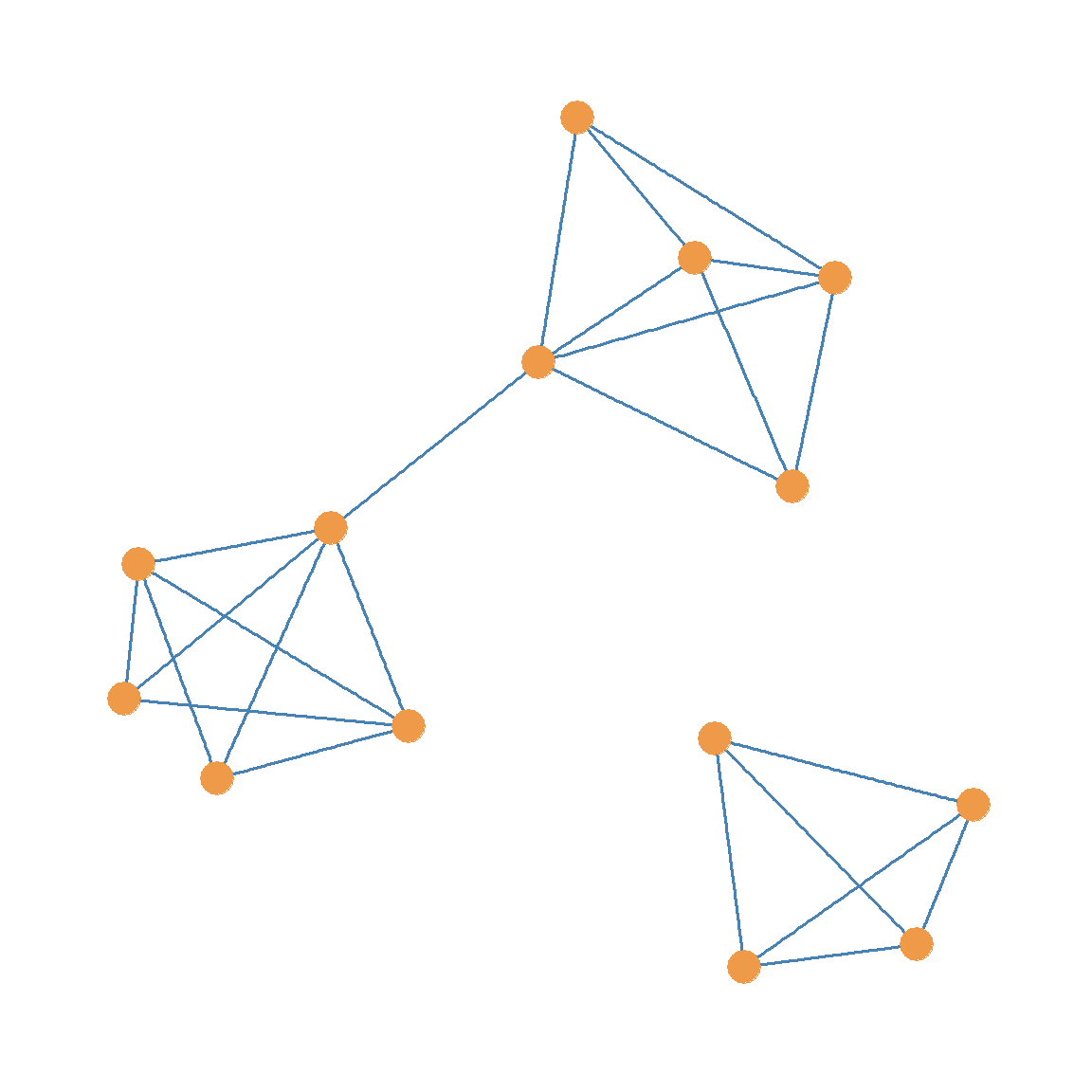
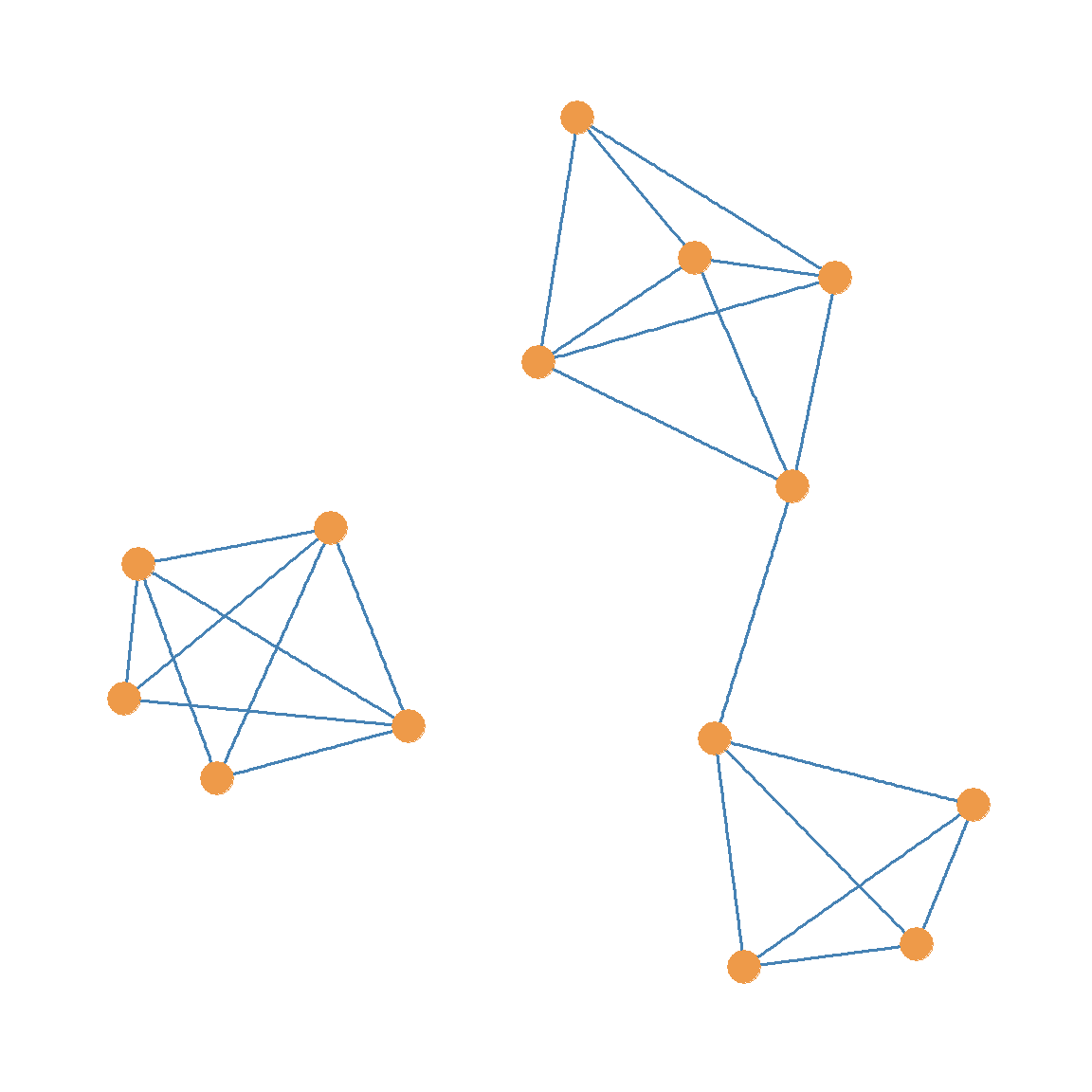
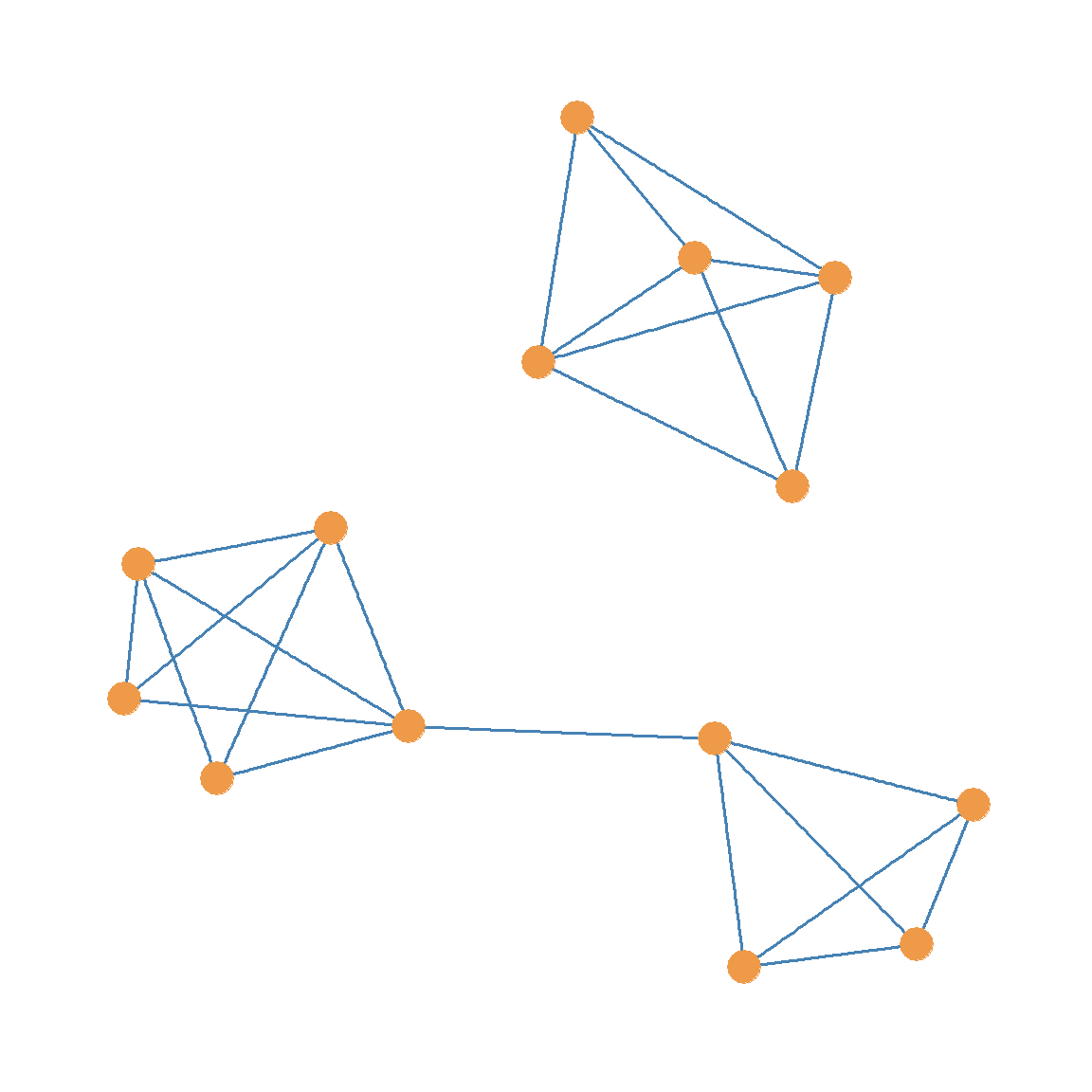
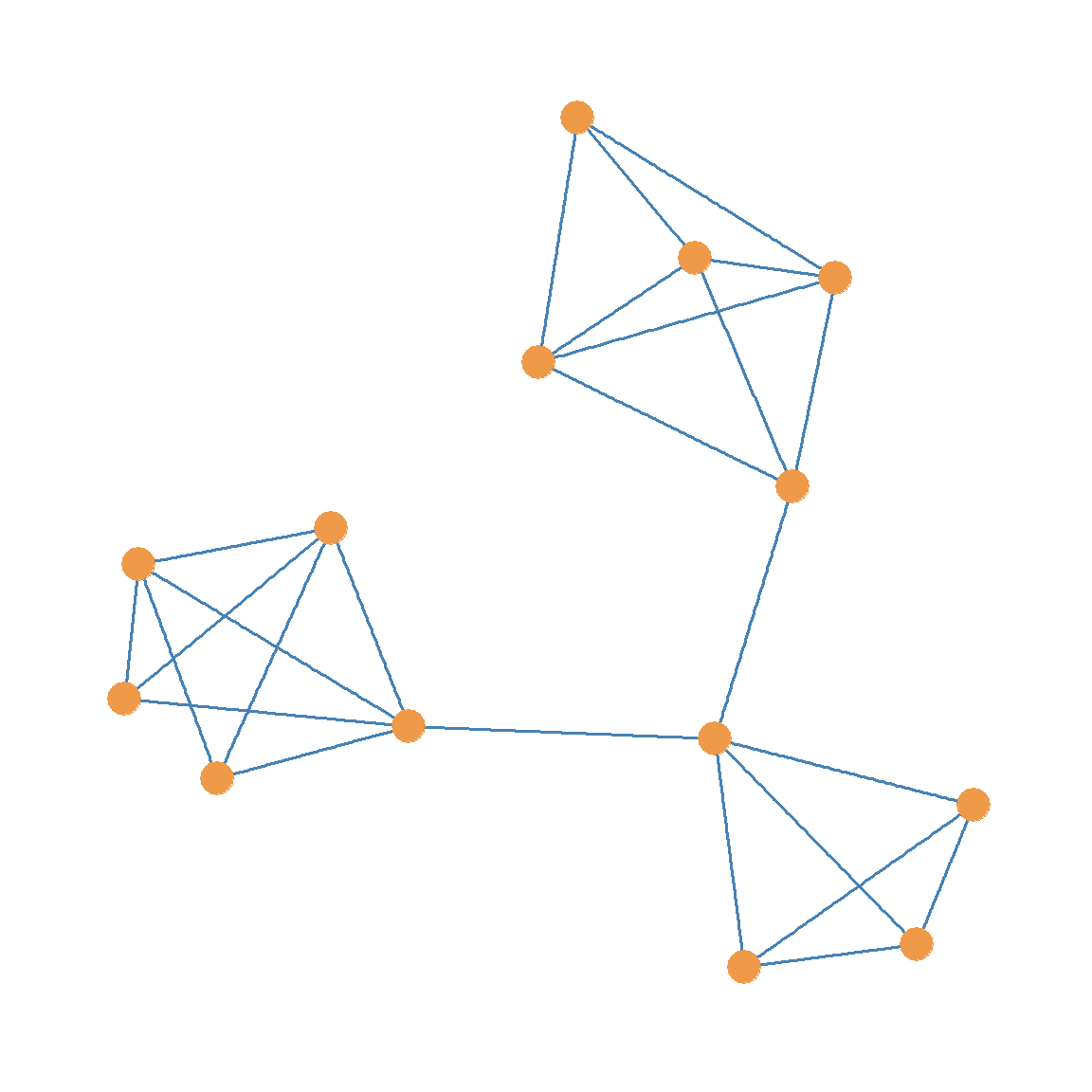
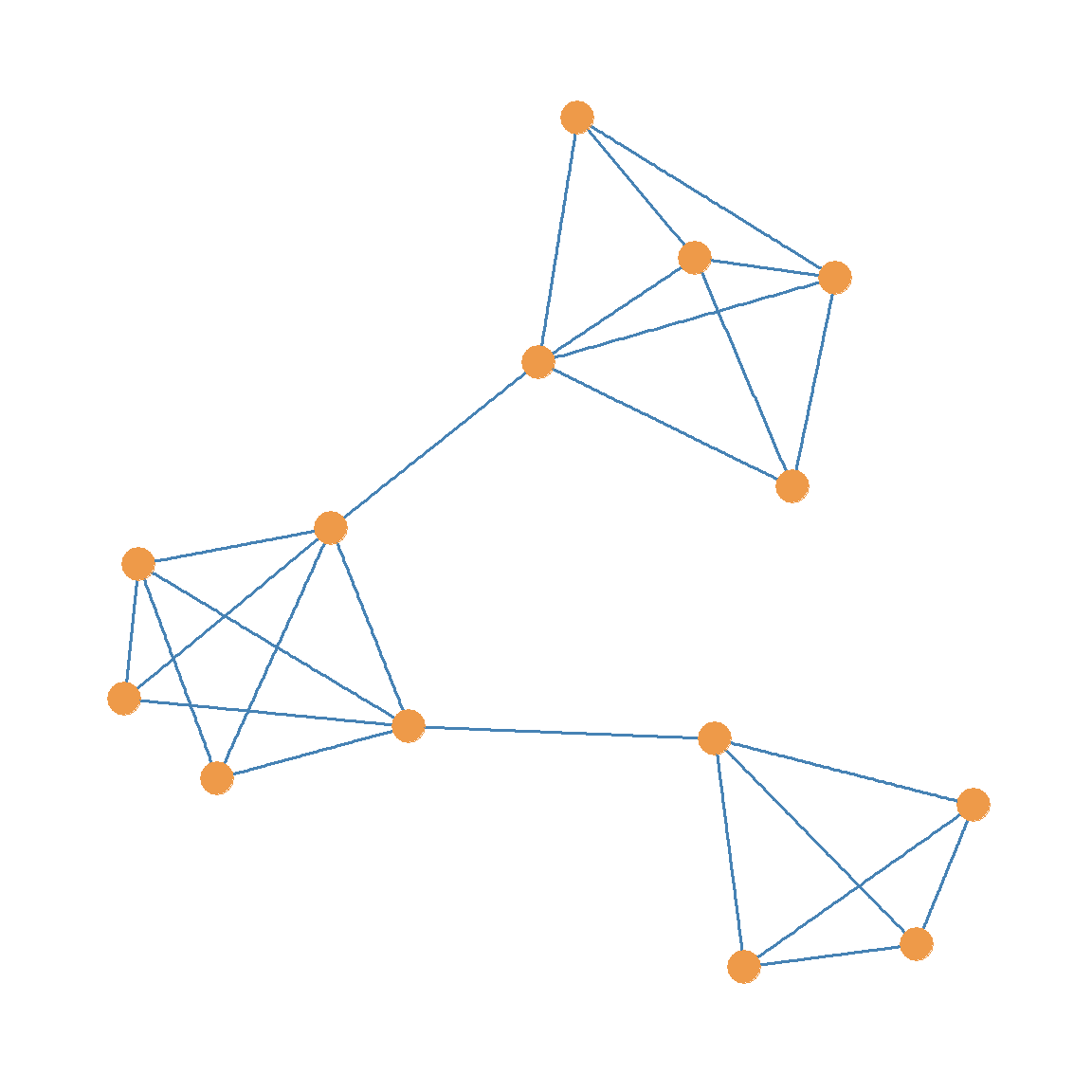
It is possible to split a graph into multiple components not just two. For instance, take a look at the unlabeled graph in Figure 13.2. If we were to generate a subgraph from Figure 13.2 by deleting the two red edges and the one purple edge, we would end up with the graph shown in Figure 13.3 (a). This graph is disconnected, and it features three separate components (connected subgraphs).
If were to delete just the red edges from Figure 13.2 and keep the purple edge, we would end up with the graph shown in Figure 13.3 (b). Like the Figure 13.3 (a), Figure 13.3 (b) is also disconnected, but it is split into two not three components.
Note that one of the connected components in the graphs shown in Figure 13.3 (b), Figure 13.3 (c), and Figure 13.3 (d) is way larger than the other one. For instance, the bigger connected component of graph Figure 13.3 (b) is of order ten, but the smaller component is only of order four.
When a disconnected graph is split into multiple components, the component containing the largest number of nodes (the connected subgraph of the highest order) is called the graph’s giant component.
13.3 Edge Connectivity
We went from the connected graph shown in Figure 13.2 to the disconnected graphs in Figure 13.3 by removing particular edges, like the red and purple ones in Figure 13.2.
These edges are clearly more important than the other colored blue in the graph, because they are responsible for keeping the whole graph together as a connected structure. Obviously this property of edges has a name in graph theory.
In a graph, an edge cutset is any set of edges whose removal results in a graph going from being connected to disconnected.
For instance, in Figure 13.2 the set of two red edges is a cutset of the graph \(G\) since deleting these edges would disconnect the graph as shown in Figure 13.3 (b). In the same way we can see that a subset that combines any one of the red edges with the purple edge is also a cutset of the graph in Figure 13.2, because removing any combination of these two links results in a disconnected graph, as shown in Figure 13.3 (c) and Figure 13.3 (d).
Generally, picking a bigger edge cutset will result in more disconnected components. For instance, selecting both the red edges and the purple edge—a cutset of cardinality three—as the cutset results in a graph with three disconnected components, as in Figure 13.3 (a).
A minimum edge cutset of a graph is any edge cutset that also happens to be of the smallest size (in terms of cardinality) among all the possible cutsets. The cardinality of the minimum edge cutset in the graph is called the graph’s edge connectivity, and it is written \(\lambda(G)\).
The graph in Figure 13.2 has edge-connectivity \(\lambda(G) = 2\) because we need to remove at least two edges to disconnected it. As we saw earlier these could be either the set the two red edges of any combination featuring one of the red ones with the purple one.
When a graph has edge-connectivity larger than one, like Figure 13.2, it means that we could remove any one edge and the graph would still be connected. For instance, looking at Figure 13.2, if we were to remove just the purple edge, the graph would still be connected, and it would look like Figure 13.3 (e), which is a connected graph.
The same would happen if we removed just one of the red edges from Figure 13.2. If were to do that, we would end up with the graph shown in Figure 13.3 (f), which is still a connected graph.
13.3.1 Bridges
As you might imagine, the smallest edge connectivity a connected graph can have is \(\lambda(G) = 1\). A graph with edge-connectivity equal to one has a special edge called a bridge. This is the single edge whose removal disconnects a graph with edge-connectivity equal to one.
For instance, in Figure 13.1 (a) the \(DF\) edge is a bridge. When a graph is like the one shown in Figure 13.1 (a) and has a bridge (like \(DF\)), this edge has two interesting properties (Buckley and Harary 1990, 17).
- First, if an edge is a bridge in graph \(G\), then that edge does not lie on any cycle of \(G\) (as defined in Chapter 11). That means that \(DF\) in Figure 13.1 (a) does not lie on any cycle of \(G\).
- Second, if an edge is a bridge, then there is at least one pair of nodes i and j such that the bridge is an edge on every path linking i and j. In Figure 13.1 (a), clearly condition (2) is the case for every node in the subset \(\{F, G, H, I\}\) relative to nodes in the subset \(\{A, B, C, D, E\}\). Every path linking nodes in the first subset to nodes in the second subset has to include the bridge \(DF\).
13.4 Node Connectivity
As you recall from Chapter 4, we can create subgraphs by removing either edges or nodes. In the same way, we can take a graph from being connected by removing either edges or nodes. In Section 13.3 we considered the case of removing edges to disconnect a graph. Here, we consider the case of removing nodes.
In a graph, a node cutset is any set of nodes whose removal results in a graph going from being connected to disconnected.
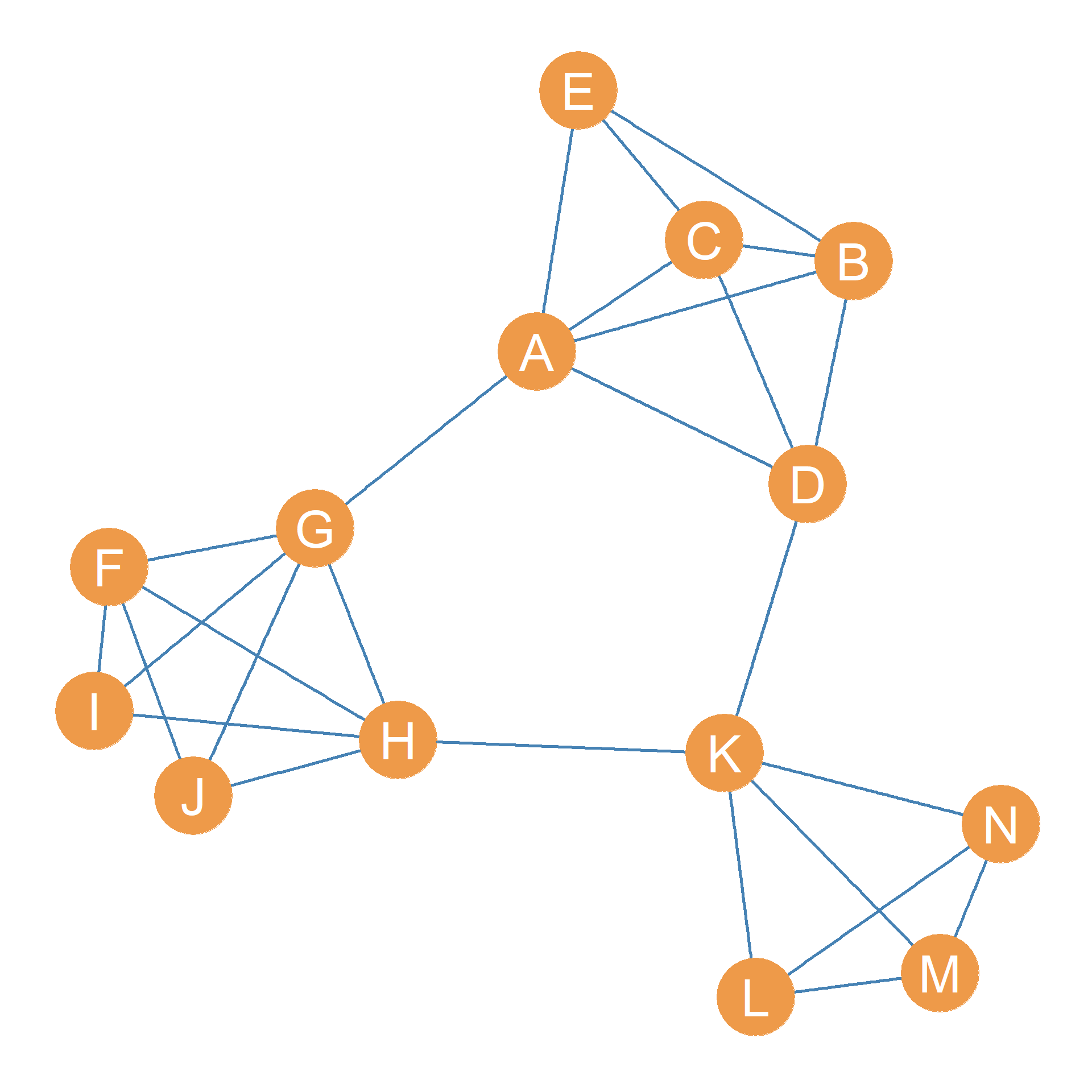
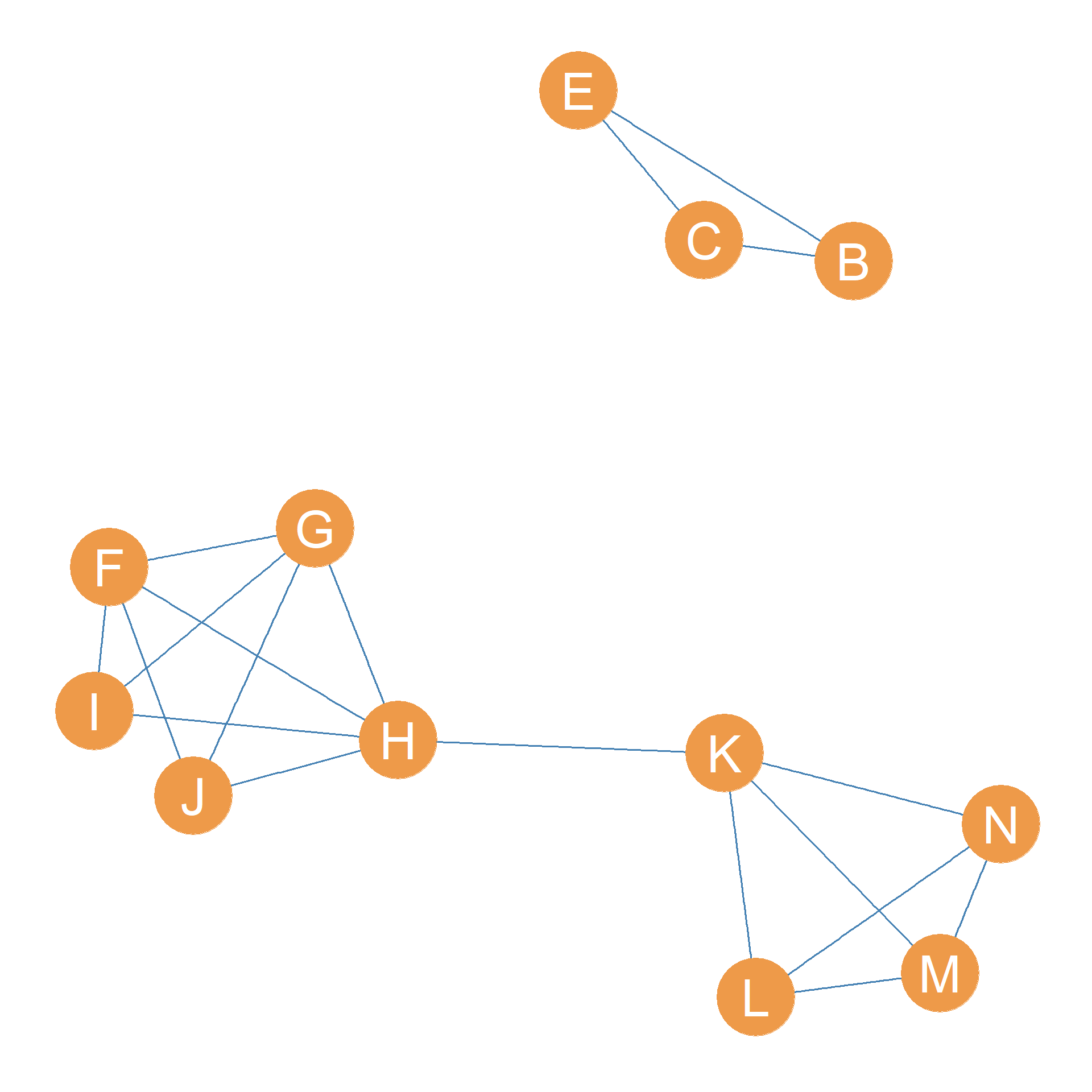
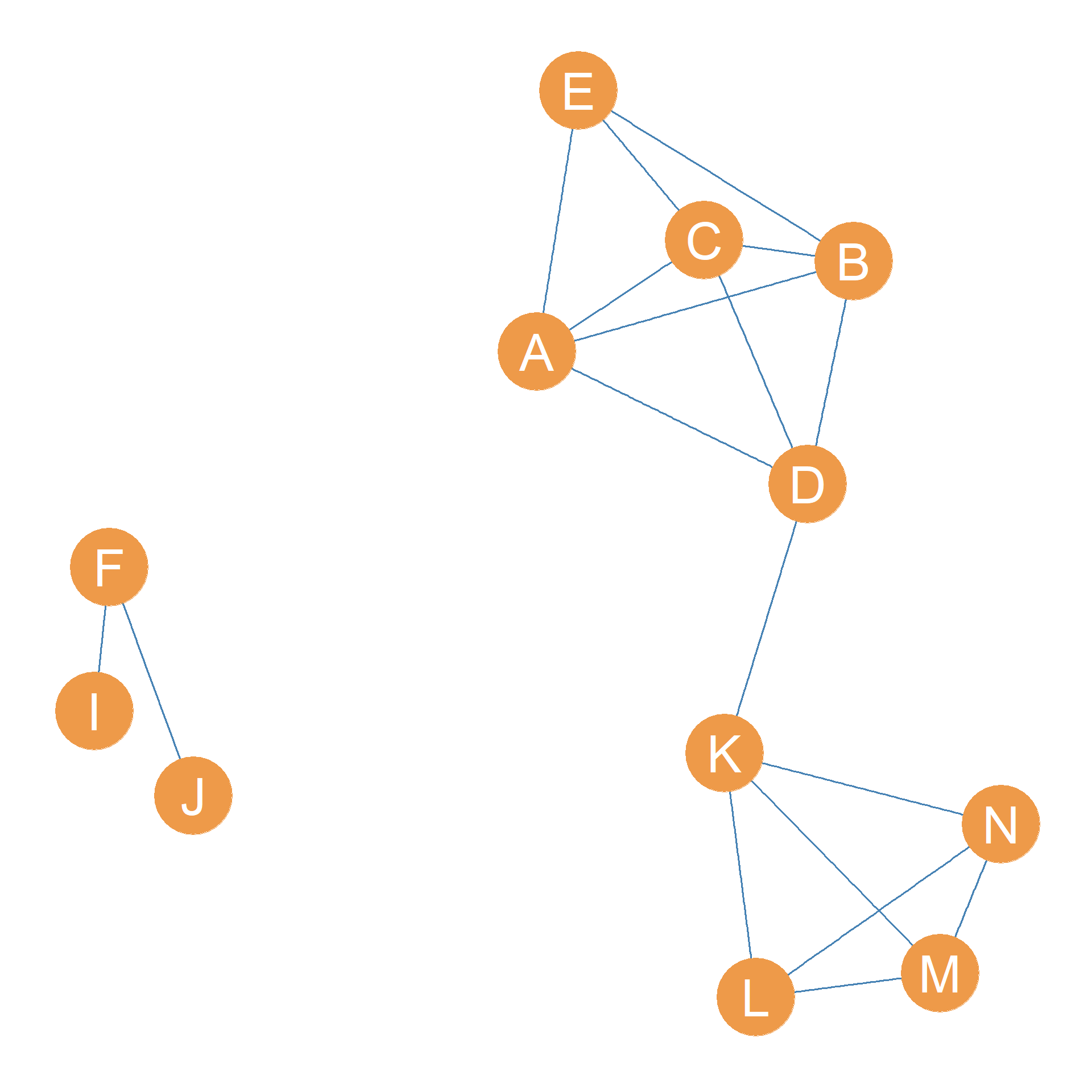
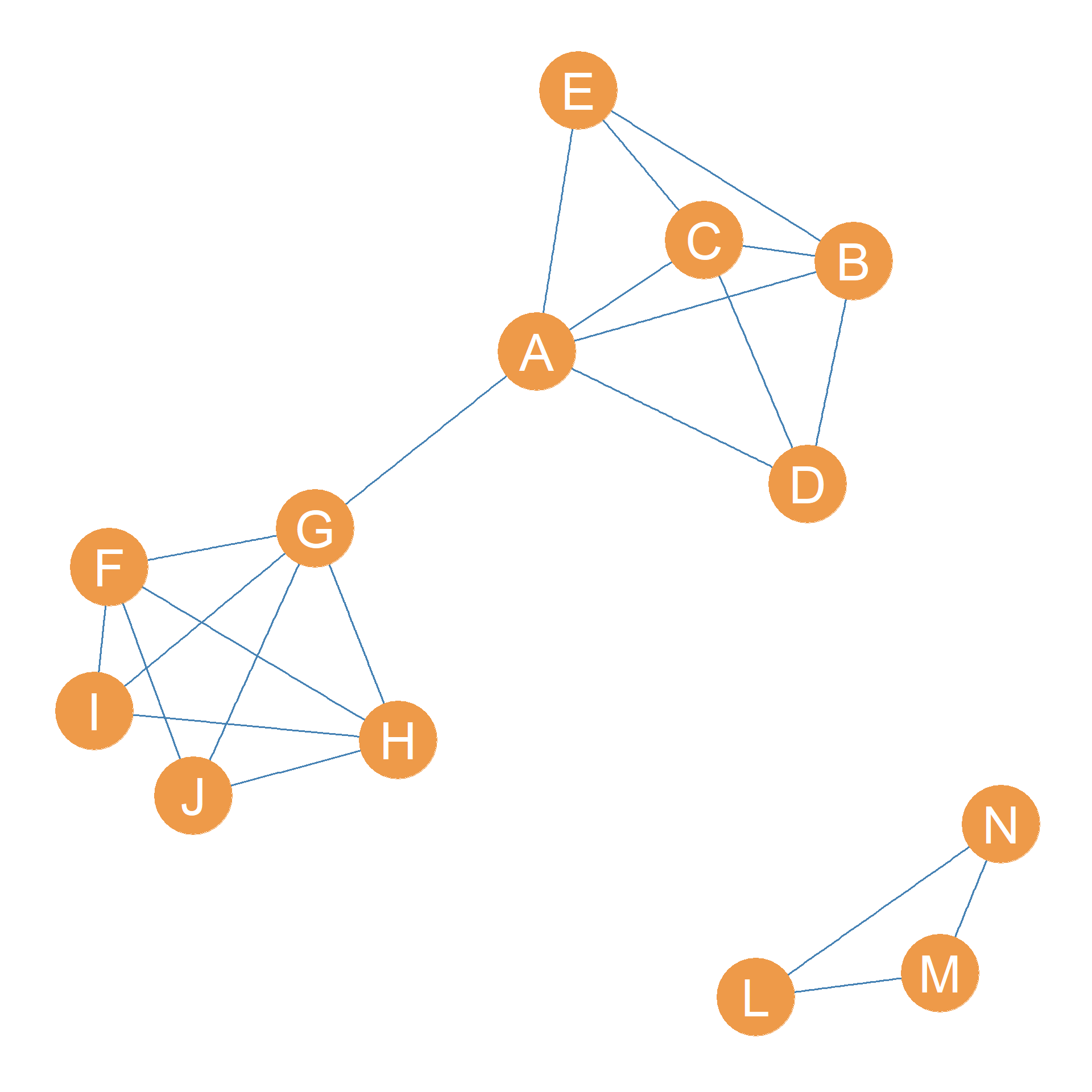
Figure 13.4 (a) shows a graph that is the same as Figure 13.3, except that the nodes are labeled. In that graph, the set of nodes \(\{A, D\}\) is a cutset of the graph \(G\) since deleting these nodes disconnects the graph, as shown by the resulting node-deleted subgraph shown in Figure 13.4 (b). This graph is now disconnected, featuring a nine-node giant component and a smaller three-node component containing nodes \(\{B, C, E\}\)
In the same way we can see that the set of nodes \(\{G, H\}\) is also a cutset of the graph, because removing these nodes would separate \(\{F, I, J\}\) from the rest of their friends, creating a graph with two separate components, as shown in Figure 13.4 (c).
Interestingly, the set formed by the single node \(K\) is also a cutset of the graph. As shown in Figure 13.4 (d), removing this one node disconnects the graph, separating \(\{L, M, N\}\) from the rest.
A minimum node cutset of a graph is any node cutset that also happens to be of the smallest size (in terms of cardinality). The cardinality of the minimum node cutset in the graph is called the graph’s node connectivity, and it is written \(\kappa(G)\).
The graph in Figure 13.4 (a) has node-connectivity (\(\kappa(G) = 1\)) because, as we have seen, all we need to do is remove \(K\) to disconnect it.
13.4.1 Articulation (Cut)Nodes
If a graph has a single node whose removal disconnects the graph then that node is called the articulation node of the graph (also called a cutnode). The articulation node is the node equivalent of what a bridge is for edges. A single actor upon whom the entire connectivity of the network depends.
If a graph \(G\) has an articulation node, then by definition \(\kappa(G) = 1\). Any graph \(G\) with \(\kappa(G) > 1\), therefore, lacks an articulation node. It follows from this that if a graph has node-connectivity larger than one (\(\kappa(G) > 1\)), we could remove any one node and the graph would still be connected.
Articulation nodes have another interesting property related to indirect connectivity. If a graph has an articulation node u, there is at least one other node in the graph v such that u stands in the middle of every path (as an inner node) connecting v to the rest of the other nodes in the graph.
Finally, if a node in a graph has degree \(k = 1\) (that is the node is an end-node) then it cannot be an articulation node. We can always remove an end-node from a connected graph and the graph will stay connected.
The larger the graph connectivity (\(\kappa(G)\)) of a graph, then the larger is the structural cohesion of the underlying social network represented by the graph (White and Harary 2001).
13.4.2 Graph Connectivity and Minimum Degree
An interesting mathematical relationship obtains between three graph properties: Minimum Degree (covered in Chapter 10) and the edge and node connectivities.
It goes as follows: In every graph the node connectivity is always smaller or equal to the edge connectivity which is always smaller or equal to the minimum degree (Harary 1969, 43).
In mathese, for any graph \(G\):
\[ \kappa(G) \leq \lambda(G) \leq min(k) \tag{13.1}\]
Neat! These can be interpreted as three different criteria that tells us whether how well-connected a whole graph, a subgraph, or a component of a larger is. Having a high minimum degree is the weakest, followed by having a high edge-connectivity, with having a high node connectivity being the strongest criterion.
13.5 Advanced: Local Bridges
In a classic paper on “The Strength of Weak Ties,” Mark Granovetter (1973) developed the concept of a local bridge. Recall from section Section 13.3.1, that a bridge is an edge that if removed would completely disconnect the graph.
Another way of thinking about this is that a bridge is an edge that if removed would increase the length of the shortest paths between two sets of nodes from a particular number to infinity since, in a disconnected graph, the length of the path between nodes that cannot reach one another is indeed infinity! (\(\infty\)).
There is another way of thinking of bridges in the context of shortest paths and this is with respect to what happens to the indirect connectivity between particular pairs of nodes in the graph when a specific edge is removed. Clearly, every time we remove an edge, this has to affect the indirect connectivity between pair of nodes, by for instance, increasing their geodesic distance (the length of the shortest path linking them).
So even if a graph remains connected after removing an edge (because its edge-connectivity is larger than one), removing an edge can affect how close two nodes in the network are. That is what the concept of a local bridge is intended to capture.
Formally, a local bridge is an edge that if removed from the graph, would increase the length of the shortest path between a particular pair of nodes to a number that is higher than their current one but less than infinity. This number is called the degree of the local bridge in question. Because a local bridge is always defined with respect to a particular pair of nodes, it is a triplet, involving two nodes i and j and one edge uv.

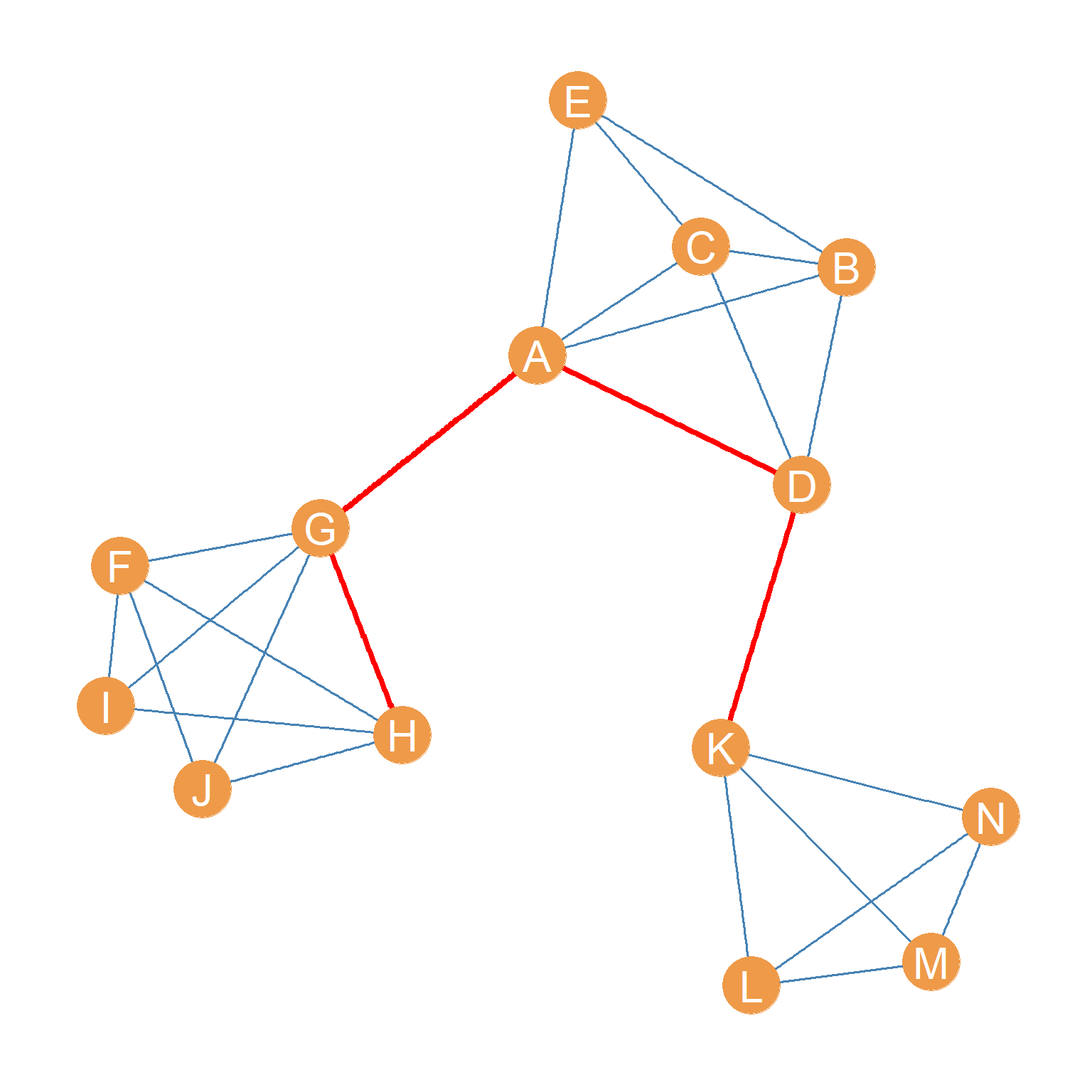
For instance, in Figure 13.5 (a), with respect to nodes \(A\) and \(H\), the edge \(HK\) (pictured in purple) is a local bridge of degree 4. The reason for that is that, as shown in Figure 13.5 (b), when the edge \(HK\) is removed from the graph, the shortest path_ between nodes \(H\) and \(K\) increases from \(l_{HK} =1\) (\(H\) and \(K\) are adjacent in Figure 13.5 (a)) to \(l_{HK} = 4\), as given by the edge sequence \(\{GH, AG, AD, DK\}\) (pictured in red).
Note that from the perspective of nodes \(D\) and \(H\), the purple \(HK\) edge is a local bridge of degree three, because \(l_{DH} = 2\) in Figure 13.5 (a) and \(l_{DH} = 3\) when the edge \(HK\) is removed from the graph in Figure 13.5 (b).